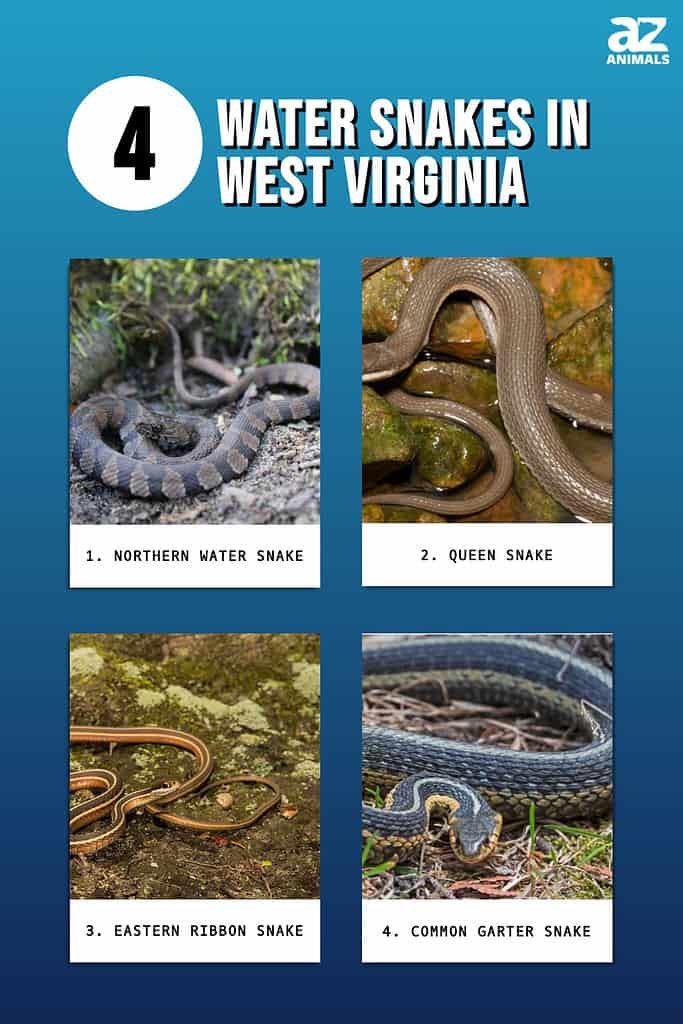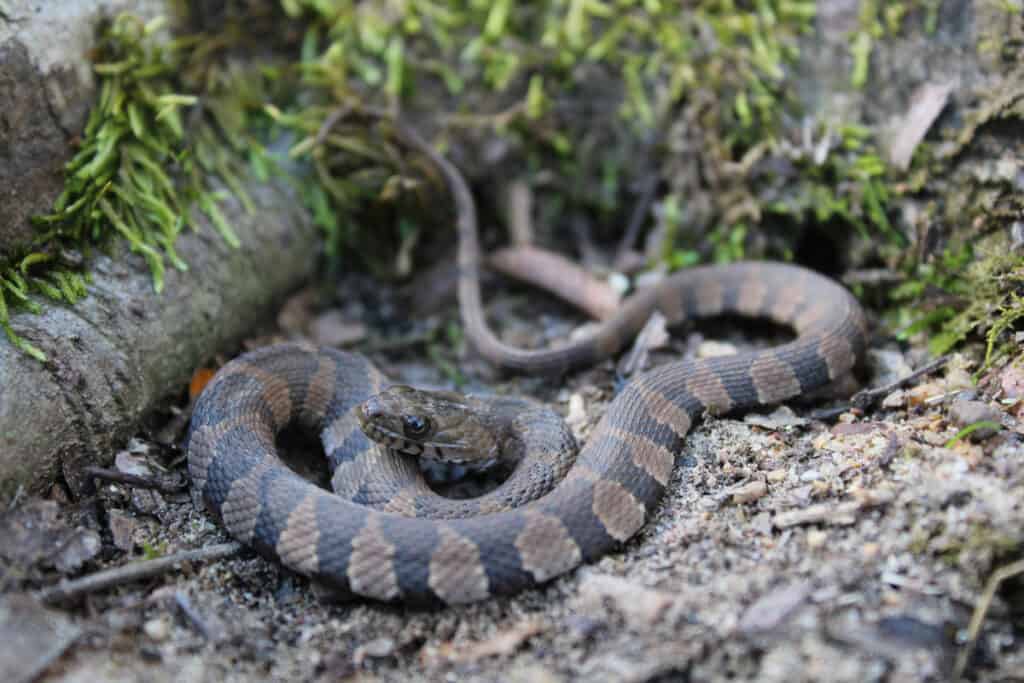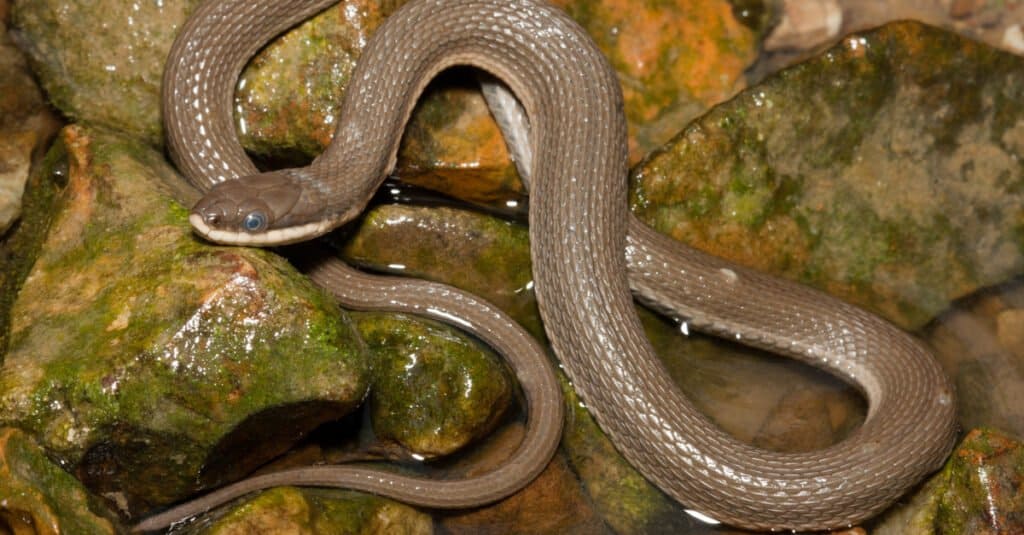Located in the southern region of the U.S., West Virginia is best known for its rugged, yet beautiful mountains. However, these give way to a vast network of rivers, including the Ohio River. These wetlands are home to numerous animals, from fish to frogs, and even snakes. That’s right, there are four water snakes in West Virginia. Let’s take a look at where they live and what they look like. We’ll also discover whether any of them are dangerous!

1. Northern Water Snake (Nerodia sipedon)

Northern water snakes live in most freshwater habitats across the state.
©Tucker Heptinstall/Shutterstock.com
The first snake on the list is the northern water snake, which is a large, powerful snake that reaches approximately 5 feet long. Northern water snakes have tan to grayish-brown bodies with dark or reddish-brown markings. Their markings begin as crossbands at their neck and then become large blotches as they approach their tail. Many northern water snakes become darker as they age, so eventually they may become almost entirely black. They are often mistaken for cottonmouths, given their similar appearance, although cottonmouths don’t occur in West Virginia.
Northern water snakes live in most freshwater habitats, including swamps, streams, rivers, and lakes. They rarely stray far from the water, but may sometimes be seen basking on the shore. They are typically quick to flee back into the safety of the water as the first sign of any potential threat. However, they can be highly defensive if they are threatened and may bite. Northern water snakes prey predominantly on fish and frogs, which they swallow alive.
2. Queen Snake (Regina septemvittata)

Queen snakes have plate-like scales on their heads to protect them in their rocky habitat.
©Nathan A Shepard/Shutterstock.com
The next water snake in West Virginia is the queen snake. Queen snakes are widespread across the state and inhabit rocky-bottomed rivers and streams. They are approximately 3 feet long and have a series of unique characteristics to help them live in their preferred habitat. This is because they have a noticeably flattened head and large, plate like scales on the top of it. They also have thick scales underneath their chin. This is because they prey almost exclusively on freshly molted crayfish and often need to reach underneath and between the rocks in search of them. Therefore, the thicker scales provide them with protection. Queen snakes are typically brown with a yellow belly. They have four dark stripes on their belly and several stripes on their dorsal side. However, the dorsal stripes are usually only visible on juveniles.
Queen snakes are diurnal and can often be observed near the water’s edge. They are usually active between April and October with the females giving birth in the late summer or early fall. They are ovoviviparous so the females retain eggs inside them until they hatch, then give birth to live young.
3. Eastern Ribbon Snake (Thamnophis saurita)

Eastern ribbon snakes prefer to inhabit areas around slow-moving bodies of water.
©Jay Ondreicka/Shutterstock.com
The eastern ribbon snake is a semi-aquatic snake, which typically lives close to water, with a preference for slow-moving water. They only occur in small, scattered populations in West Virginia, and tend to inhabit swamps and marshes. Eastern ribbon snakes are approximately 18 to 26 inches long and have slender dark brown to black bodies. They also have three distinctive yellow stripes — one down the center of their back and one down each side on scale rows three and four. They also have white upper lips and vertical white markings next to their eyes.
Eastern ribbon snakes are not venomous and typically pose no threat to humans, although they may defecate or release a foul-smelling musk if they are handled. They prey on a variety of fish, frogs, and salamanders, which are all swallowed alive. Eastern ribbon snakes give birth to approximately 10 to 12 juveniles, which are only seven to nine inches long.
4. Common Garter Snake (Thamnophis sirtalis)

Common garter snakes produce a venom-like substance, which they use to immobilize their prey.
©iStock.com/Wildnerdpix
The final water snake in West Virginia is the common garter snake, which has a similar appearance to the eastern ribbon snake. Common garter snakes are typically 18 to 30 inches long and again have a dark ground color, which is overlaid with three brightly-colored stripes. However, the stripes on common garter snakes occur on the second and third row of scales and can be either cream, yellow, orange, or even blue.
Common garter snakes are fairly widespread in West Virginia and live in a variety of habitats, including meadows and hillsides. However, they typically inhabit areas close to water and are capable swimmers, preying on a range of fish and amphibians. Although they are not considered to be dangerous to humans, common garter snakes are slightly venomous. They don’t contain true venom, but it’s a venom-like substance which is produced in the Durvenoy gland and can be used to immobilize their prey. However, they don’t inject it with fangs. Instead, it is in their saliva and is simply chewed into their prey.
Summary of 4 Water Snakes That Call West Virginia Home
Here’s a recap of four types of water snakes found in West Virginia that we took a look at.
| Number | Water Snake | Scientific Name | Habitat |
|---|---|---|---|
| 1 | Northern Water Snake | Nerodia sipedon | Most freshwater habitats, including swamps, streams, rivers, and lakes |
| 2 | Queen Snake | Regina septemvittata | Widespread across the state in rocky-bottomed rivers and streams |
| 3 | Eastern Ribbon Snake | Thamnophis saurita | Small, scattered populations in West Virginia that inhabit swamps and marshes |
| 4 | Common Garter Snake | Thamnophis sirtalis | Fairly widespread in the state in a variety of habitats including meadows and hillsides |
The photo featured at the top of this post is © Jason Patrick Ross/Shutterstock.com
Discover the "Monster" Snake 5X Bigger than an Anaconda
Every day A-Z Animals sends out some of the most incredible facts in the world from our free newsletter. Want to discover the 10 most beautiful snakes in the world, a "snake island" where you're never more than 3 feet from danger, or a "monster" snake 5X larger than an anaconda? Then sign up right now and you'll start receiving our daily newsletter absolutely free.
Thank you for reading! Have some feedback for us? Contact the AZ Animals editorial team.






